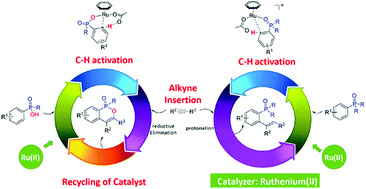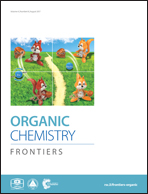A theoretical study on the mechanism of ruthenium(ii)-catalyzed phosphoryl-directed ortho-selective C–H bond activations: the phosphoryl hydroxy group triggered Ru(ii)/Ru(0) catalytic cycle†
Abstract
Using density functional theory (DFT) calculations, the present study explores the mechanisms of two ruthenium(II)-catalyzed phosphoryl-directed ortho-selective C–H bond activation reactions. Depending on the nature of the phosphoryl groups, namely R2P(O) versus RP(O)OH, two different products could be selectively synthesized. For R2P(O), the overall catalytic cycle includes three basic steps: C–H bond activation, alkyne insertion, and protonation. The oxidation state of the Ru center does not change during this catalytic process. Alternatively, when RP(O)OH is used, the whole catalytic cycle involves four basic steps: C–H bond activation, alkyne insertion, reductive elimination, and catalyst recycling. This switchability is attributed to the hydroxy group of RP(O)OH, which facilitates the Ru(II)/Ru(0) catalytic cycle. Additionally, we found that most of the steps feature cationic intermediates and transition states. This is in line with experimental results showing that additives such as AgSbF6 and KPF6 are required for improved yields.



 Please wait while we load your content...
Please wait while we load your content...